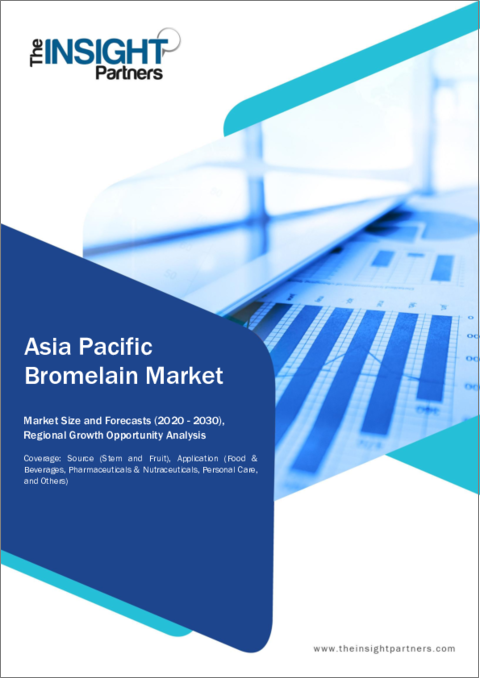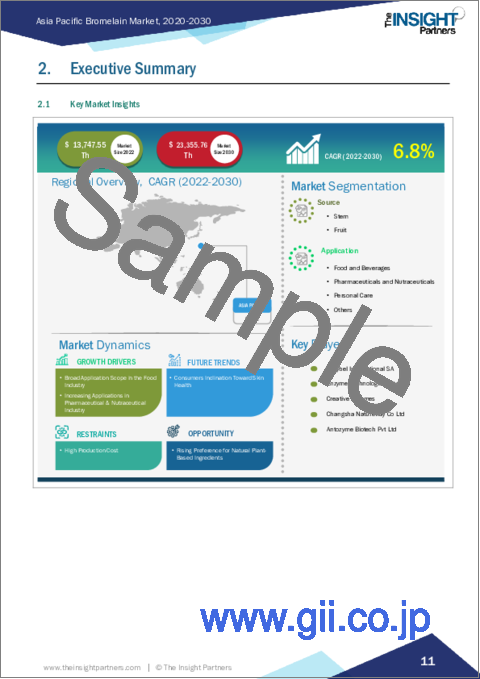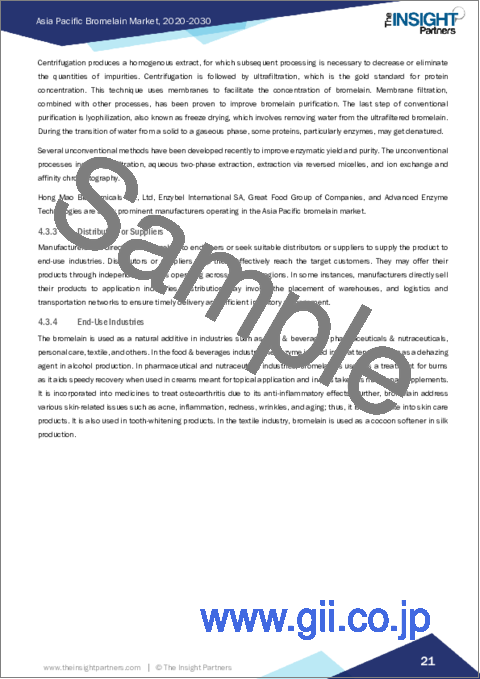|
|
市場調査レポート
商品コード
1463755
アジア太平洋地域のブロメライン:2030年までの市場予測 - 地域分析 - 原料別、用途別Asia Pacific Bromelain Market Forecast to 2030 - Regional Analysis - by Source (Stem and Fruit) and Application (Food & Beverages, Pharmaceuticals & Nutraceuticals, Personal Care, and Others) |
||||||
|
|||||||
| アジア太平洋地域のブロメライン:2030年までの市場予測 - 地域分析 - 原料別、用途別 |
|
出版日: 2024年02月07日
発行: The Insight Partners
ページ情報: 英文 71 Pages
納期: 即納可能
|
全表示
- 概要
- 図表
- 目次
アジア太平洋地域のブロメライン市場は2022年に1,375万米ドルと評価され、2030年には2,336万米ドルに達すると予測され、2022年から2030年までのCAGRは6.8%で成長すると推定されます。
天然植物由来成分への嗜好の高まりがアジア太平洋地域のブロメライン市場を後押し
消費者は天然添加物やクリーンラベルの原材料を使用した製品を求めるようになっています。パイナップル由来の天然酵素であるブロメラインは、様々な産業で合成添加物よりも天然添加物として好まれています。消費者は、総合的な健康維持に役立つより安全な製品を消費する傾向にあります。化学物質を含まない製品への関心の高まりは、医薬品や栄養補助食品、飲食品、化粧品などの業界において、ブロメラインのような天然添加物の需要を押し上げています。
ブロメラインは、動物性プロテアーゼよりも植物性プロテアーゼの方が病気感染のリスクが低いため、消費者に好まれています。さらに、環境問題、持続可能性、低価格、動物福祉、宗教的・倫理的問題などが、ブロメラインの人気を後押ししています。国によっては、組み換え技術から合成された酵素の食品産業での使用が禁止されています。いくつかの国では、動物性プロテアーゼや微生物発酵は宗教的問題(ハラール遵守など)の対象となるが、植物性成分を使用することで回避できます。このように、天然植物由来成分への嗜好の高まりは、予測期間中にアジア太平洋地域のブロメライン市場に有利な成長機会を生み出すと期待されています。
アジア太平洋地域のブロメライン市場概要
アジア太平洋地域のブロメライン市場は、オーストラリア、中国、日本、インド、韓国、その他アジア太平洋地域に細分化されます。アジア太平洋地域は世界最大のパイナップル生産国であり、その主な理由は最適な土地の利用可能性と良好な気温条件です。ブロメラインは主にパイナップルが栽培されている地域で生産されています。国連食糧農業機関統計データベース(FAOSTAT)によると、ブラジル、インドネシア、タイ、中国、インドがパイナップル生産量上位のアジア諸国のひとつです。したがって、この地域のブロメライン生産量の多さは、原料の安定供給と関連しており、その結果、生産コストが低くなっています。
ブロメラインは主に肉の軟化に使用されるため、アジア太平洋地域のブロメライン市場の成長には、同地域で急成長している食肉産業が有利に働く。経済協力開発機構(OECD)と国連食糧農業機関(FAO)によると、中国は2021年に約1億トンの食肉を消費し、これは世界の総消費量の27%に相当し、米国の消費量の2倍にあたる。したがって、ブロメラインの需要は中国で高いです。
アジア太平洋地域の新興国では、ソーシャルメディアの影響で健康志向の消費者が増えています。ブロメラインの需要は、この地域での栄養補助食品、個人用およびスポーツ用栄養製品の人気の高まりとともに増加しています。機能性食品や飲食品は、健康志向の人々の間で絶大な人気を博しています。ブロメラインはアジア太平洋地域で栄養補助食品成分として人気を集めています。その結果、ブロメラインを強化したフェイスマスクやその他の化粧品が同地域のスキンケアのトレンドになりつつあり、これが同地域の市場にさらなる利益をもたらしています。
アジア太平洋地域のブロメライン市場の収益と2030年までの予測(千米ドル)
アジア太平洋地域のブロメライン市場のセグメンテーション
アジア太平洋地域のブロメライン市場は、供給源、用途、国に区分されます。
供給源に基づき、アジア太平洋地域のブロメライン市場は茎と果実に二分されます。2022年には茎市場セグメントのシェアが大きくなった。
用途別では、アジア太平洋地域のブロメライン市場は飲食品、医薬品・栄養補助食品、パーソナルケア、その他に分類されます。飲食品セグメントが2022年に最大のシェアを占めました。
国別に見ると、アジア太平洋地域のブロメライン市場はオーストラリア、中国、日本、インド、韓国、その他アジア太平洋地域に区分されます。その他アジア太平洋地域が2022年のアジア太平洋地域のブロメライン市場を独占しました。
Antozyme Biotech Pvt Ltd、Challenge Bioproducts Co Ltd、Changsha Natureway Co Ltd、Creative Enzymes、Enzybel International SA、Great Food(Biochem)Co Ltd、Guangxi Nanning Javely Biological Products Co Ltd、Hong Mao Biochemicals Co Ltd、Medikonda Nutrientsなどがアジア太平洋地域のブロメライン市場で事業を展開している大手企業です。
目次
目次
第1章 イントロダクション
第2章 エグゼクティブサマリー
- 主要市場洞察
- 市場の魅力
第3章 調査手法
- 調査範囲
- 2次調査
- 1次調査
第4章 アジア太平洋地域のブロメライン市場情勢
- ポーターのファイブフォース分析
- 供給企業の交渉力
- 買い手の交渉力
- 新規参入業者の脅威
- 競争企業間の敵対関係
- 代替品の脅威
- エコシステム分析
- 原材料サプライヤー
- 製造プロセス
- 流通業者または供給業者
- 最終用途産業
- ベンダー一覧
第5章 アジア太平洋地域のブロメライン市場:主要市場力学
- 市場促進要因
- 食品産業における幅広い応用範囲
- 医薬品・栄養補助食品産業における用途の増加
- 市場抑制要因
- 高い生産コスト
- 市場機会
- 天然植物由来成分への嗜好の高まり
- 今後の動向
- 消費者の皮膚健康志向
- 促進要因と抑制要因の影響分析
第6章 ブロメライン市場:アジア太平洋地域市場分析
- アジア太平洋地域のブロメライン市場収益
- アジア太平洋地域のブロメライン市場の予測と分析
第7章 アジア太平洋地域のブロメライン市場分析:原料
- ステム
- フルーツ
第8章 アジア太平洋地域のブロメライン市場分析:用途
- 飲食品
- 医薬品・栄養補助食品
- パーソナルケア
- その他
第9章 アジア太平洋地域のブロメライン市場:国別分析
- 中国
- 日本
- インド
- オーストラリア
- 韓国
- その他
第10章 競合情勢
- ヒートマップ分析
第11章 企業プロファイル
- Hong Mao Biochemicals Co Ltd
- Enzybel International SA
- Guangxi Nanning Javely Biological Products Co Ltd
- Creative Enzymes
- Medikonda Nutrients
- Changsha Natureway Co Ltd
- Antozyme Biotech Pvt Ltd
- Challenge Bioproducts Co Ltd
- Great Food(Biochem)Co Ltd
第12章 付録
List Of Tables
- Table 1. Asia Pacific Bromelain Market Segmentation
- Table 2. List of Raw Material Suppliers in Value Chain
- Table 3. List of Manufacturers in Value Chain
- Table 4. Asia Pacific Bromelain Market Revenue and Forecasts To 2030 (US$ Thousand)
- Table 5. Asia Pacific Bromelain Market Revenue and Forecasts To 2030 (US$ Thousand) - Source
- Table 6. Asia Pacific Bromelain Market Revenue and Forecasts To 2030 (US$ Thousand) - Application
- Table 7. China: Asia Pacific Bromelain Market Revenue and Forecasts To 2030 (US$ Thousand) - by Source
- Table 8. Japan: Asia Pacific Bromelain Market Revenue and Forecasts To 2030 (US$ Thousand) - Source
- Table 9. Japan: Asia Pacific Bromelain Market Revenue and Forecasts To 2030 (US$ Thousand) - Application
- Table 10. India: Asia Pacific Bromelain Market Revenue and Forecasts To 2030 (US$ Thousand) - Source
- Table 11. India: Asia Pacific Bromelain Market Revenue and Forecasts To 2030 (US$ Thousand) - Application
- Table 12. Australia: Asia Pacific Bromelain Market Revenue and Forecasts To 2030 (US$ Thousand) - Source
- Table 13. Australia: Asia Pacific Bromelain Market Revenue and Forecasts To 2030 (US$ Thousand) - Application
- Table 14. South Korea: Asia Pacific Bromelain Market Revenue and Forecasts To 2030 (US$ Thousand) - by Source
- Table 15. South Korea: Asia Pacific Bromelain Market Revenue and Forecasts To 2030 (US$ Thousand) - Application
- Table 16. Rest of Asia Pacific Bromelain Market Revenue and Forecasts To 2030 (US$ Thousand) - Source
- Table 17. Rest of Asia Pacific Bromelain Market Revenue and Forecasts To 2030 (US$ Thousand) - Application
- Table 18. Heat Map Analysis
List Of Figures
- Figure 1. Asia Pacific Bromelain Market Segmentation, By Country
- Figure 2. Porter's Five Forces Analysis: Asia Pacific Bromelain Market
- Figure 3. Ecosystem: Asia Pacific Bromelain Market
- Figure 4. Asia Pacific Bromelain Market - Key Industry Dynamics
- Figure 5. Asia Pacific Bromelain Market Impact Analysis of Drivers and Restraints
- Figure 6. Asia Pacific Bromelain Market Revenue (US$ Thousand), 2020 - 2030
- Figure 7. Asia Pacific Bromelain Market Share (%) - Source, 2022 and 2030
- Figure 8. Stem Market Revenue and Forecasts To 2030 (US$ Thousand)
- Figure 9. Fruit Market Revenue and Forecasts To 2030 (US$ Thousand)
- Figure 10. Asia Pacific Bromelain Market Share (%) -Application, 2022 and 2030
- Figure 11. Food & Beverages Market Revenue and Forecasts To 2030 (US$ Thousand)
- Figure 12. Pharmaceuticals & Nutraceuticals Market Revenue and Forecasts To 2030 (US$ Thousand)
- Figure 13. Personal Care Market Revenue and Forecasts To 2030 (US$ Thousand)
- Figure 14. Others Market Revenue and Forecasts To 2030 (US$ Thousand)
- Figure 15. Asia Pacific Bromelain Market , by Key Country - Revenue (2022) (US$ Thousand)
- Figure 16. Asia Pacific Bromelain Market Breakdown by Key Countries, 2022 And 2030 (%)
- Figure 17. China: Asia Pacific Bromelain Market Revenue and Forecasts To 2030 (US$ Thousand)
- Figure 18. Japan: Asia Pacific Bromelain Market Revenue and Forecasts To 2030 (US$ Thousand)
- Figure 19. India: Asia Pacific Bromelain Market Revenue and Forecasts To 2030 (US$ Thousand)
- Figure 20. Australia: Asia Pacific Bromelain Market Revenue and Forecasts To 2030 (US$ Thousand)
- Figure 21. South Korea: Asia Pacific Bromelain Market Revenue and Forecasts To 2030 (US$ Thousand)
- Figure 22. Rest of Asia Pacific Bromelain Market Revenue and Forecasts To 2030 (US$ Thousand)
The Asia Pacific bromelain market was valued at US$ 13.75 million in 2022 and is expected to reach US$ 23.36 million by 2030; it is estimated to grow at a CAGR of 6.8% from 2022 to 2030.
Rising Preference for Natural Plant-Based Ingredients Fuels the Asia Pacific Bromelain Market
Consumers are increasingly seeking products with natural additives and clean-label ingredients. Bromelain, a natural enzyme derived from the pineapple plant, is preferred as a natural additive over synthetic additives in various industries. Consumers are inclined toward consuming safer products that help them maintain overall health. The growing interest in chemical-free products boosts the demand for natural additives such as bromelain in industries such as pharmaceutical and nutraceuticals, food & beverages, and cosmetics.
Bromelain is a plant protease preferred by consumers over animal proteases, as they carry a lower risk of disease transmission. Moreover, environmental concerns; sustainability; lower prices; and animal welfare, religious, and ethical issues are among other parameters driving the popularity of bromelain. In some countries, the use of enzymes synthesized from recombinant technology is prohibited in the food industry. In several countries, animal proteases or microbial fermentation are subject to religious issues (such as Halal compliance), which can be avoided by using plant-based components. Thus, the rising preference for natural, plant-based ingredients is expected to create lucrative growth opportunities in the Asia Pacific bromelain market during the forecast period.
Asia Pacific Bromelain Market Overview
The Asia Pacific bromelain market is sub-segmented into Australia, China, Japan, India, South Korea, and the Rest of Asia Pacific. Asia Pacific is the largest producer of pineapple globally, which can be mainly attributed to optimum land availability and favorable temperature conditions; thus, major manufacturing units of bromelain are present in the region. Bromelain produced mainly in parts of the world where pineapples are grown. According to the Food and Agriculture Organization Statistic Database (FAOSTAT), Brazil, Indonesia, Thailand, China, and India are among the top pineapple-producing Asian countries. Thus, the high bromelain production levels in the region are associated with an uninterrupted supply of raw materials, resulting in lower production costs.
Bromelain is mainly used for meat tenderization; thus, the rapidly growing meat industry in the countries favors the Asia Pacific bromelain market growth. According to the Organization for Economic Co-Operation and Development (OECD) and the Food and Agricultural Organization (FAO), China consumed almost 100 million tons of meat in 2021, which was equivalent to 27% of the world's total consumption and twice the consumption in the US. Thus, the demand for bromelain is high in China.
The number of health-conscious consumers is increasing in emerging countries in Asia Pacific as a result of the impact of social media. The demand for bromelain is increasing with the growing popularity of nutritional supplements, and personal and sports nutrition products in this region. Functional food and beverages have gained immense popularity among the health-conscious population. Bromelain is gaining popularity as a nutricosmetic component in the Asia Pacific. As a result, bromelain-enriched face masks and other cosmetic products are becoming a skincare trend in the region, which further benefits the market in this region.
Asia Pacific Bromelain Market Revenue and Forecast to 2030 (US$ Thousand)
Asia Pacific Bromelain Market Segmentation
The Asia Pacific bromelain market is segmented into source, application, and country.
Based on source, the Asia Pacific bromelain market is bifurcated stem and fruit. The stem market segment held a larger share in 2022.
In terms of application, the Asia Pacific bromelain market is categorized into food & beverages, pharmaceuticals & nutraceuticals, personal care, and others. The food & beverages segment held the largest share in 2022.
Based on country, the Asia Pacific bromelain market is segmented Australia, China, Japan, India, South Korea, and the Rest of Asia Pacific. The Rest of the Asia Pacific dominated the Asia Pacific bromelain market in 2022.
Antozyme Biotech Pvt Ltd, Challenge Bioproducts Co Ltd, Changsha Natureway Co Ltd, Creative Enzymes, Enzybel International SA, Great Food (Biochem) Co Ltd, Guangxi Nanning Javely Biological Products Co Ltd, Hong Mao Biochemicals Co Ltd, and Medikonda Nutrients are some of the leading companies operating in the Asia Pacific bromelain market.
Table Of Contents
Table of Content
1. Introduction
- 1.1 The Insight Partners Research Report Guidance
- 1.2 Market Segmentation
2. Executive Summary
- 2.1 Key Market Insights
- 2.2 Market Attractiveness
3. Research Methodology
- 3.1 Coverage
- 3.2 Secondary Research
- 3.3 Primary Research
4. Asia Pacific Bromelain Market Landscape
- 4.1 Overview
- 4.2 Porter's Five Forces Analysis
- 4.2.1 Bargaining Power of Suppliers
- 4.2.2 Bargaining Power of Buyers
- 4.2.3 Threat of New Entrants
- 4.2.4 Competitive Rivalry
- 4.2.5 Threat of Substitutes
- 4.3 Ecosystem Analysis
- 4.3.1 Raw Material Suppliers
- 4.3.2 Manufacturing Process
- 4.3.3 Distributors or Suppliers
- 4.3.4 End-Use Industries
- 4.4 List of Vendors
5. Asia Pacific Bromelain Market - Key Market Dynamics
- 5.1 Market Drivers
- 5.1.1 Broad Application Scope in the Food Industry
- 5.1.2 Increasing Applications in Pharmaceutical & Nutraceutical Industry
- 5.2 Market Restraints
- 5.2.1 High Production Cost
- 5.3 Market Opportunities
- 5.3.1 Rising Preference for Natural Plant-Based Ingredients
- 5.4 Future Trends
- 5.4.1 Consumers Inclination Toward Skin Health
- 5.5 Impact Analysis of Drivers and Restraints
6. Bromelain Market - Asia Pacific Market Analysis
- 6.1 Overview
- 6.2 Asia Pacific Bromelain Market Revenue (US$ Thousand)
- 6.3 Asia Pacific Bromelain Market Forecast and Analysis
7. Asia Pacific Bromelain Market Analysis - Source
- 7.1 Stem
- 7.1.1 Overview
- 7.1.2 Stem Market Revenue and Forecast to 2030 (US$ Thousand)
- 7.2 Fruit
- 7.2.1 Overview
- 7.2.2 Fruit Market Revenue and Forecast to 2030 (US$ Thousand)
8. Asia Pacific Bromelain Market Analysis - Application
- 8.1 Food & Beverages
- 8.1.1 Overview
- 8.1.2 Food & Beverages Market Revenue, and Forecast to 2030 (US$ Thousand)
- 8.2 Pharmaceuticals & Nutraceuticals
- 8.2.1 Overview
- 8.2.2 Pharmaceuticals & Nutraceuticals Market Revenue, and Forecast to 2030 (US$ Thousand)
- 8.3 Personal Care
- 8.3.1 Overview
- 8.3.2 Personal Care Market Revenue, and Forecast to 2030 (US$ Thousand)
- 8.4 Others
- 8.4.1 Overview
- 8.4.2 Others Market Revenue, and Forecast to 2030 (US$ Thousand)
9. Asia Pacific Bromelain Market - Country Analysis
- 9.1.1 Asia Pacific Bromelain Market, by Key Country - Revenue (2022) (US$ Thousand)
- 9.1.2 Asia Pacific Bromelain Market Breakdown by Country
- 9.1.2.1 Asia Pacific Bromelain Market Breakdown by Country
- 9.1.2.2 China: Asia Pacific Bromelain Market Revenue and Forecasts To 2030 (US$ Thousand)
- 9.1.2.2.1 China: Asia Pacific Bromelain Market Breakdown by Source
- 9.1.2.2.2 China: Asia Pacific Bromelain Market Breakdown by Application
- 9.1.2.3 Japan: Asia Pacific Bromelain Market Revenue and Forecasts To 2030 (US$ Thousand)
- 9.1.2.3.1 Japan: Asia Pacific Bromelain Market Breakdown by Source
- 9.1.2.3.2 Japan: Asia Pacific Bromelain Market Breakdown by Application
- 9.1.2.4 India: Asia Pacific Bromelain Market Revenue and Forecasts To 2030 (US$ Thousand)
- 9.1.2.4.1 India: Asia Pacific Bromelain Market Breakdown by Source
- 9.1.2.4.2 India: Asia Pacific Bromelain Market Breakdown by Application
- 9.1.2.5 Australia: Asia Pacific Bromelain Market Revenue and Forecasts To 2030 (US$ Thousand)
- 9.1.2.5.1 Australia: Asia Pacific Bromelain Market Breakdown by Source
- 9.1.2.5.2 Australia: Asia Pacific Bromelain Market Breakdown by Application
- 9.1.2.6 South Korea: Asia Pacific Bromelain Market Revenue and Forecasts To 2030 (US$ Thousand)
- 9.1.2.6.1 South Korea: Asia Pacific Bromelain Market Breakdown by Source
- 9.1.2.6.2 South Korea: Asia Pacific Bromelain Market Breakdown by Application
- 9.1.2.7 Rest of Asia Pacific Bromelain Market Revenue and Forecasts To 2030 (US$ Thousand)
- 9.1.2.7.1 Rest of Asia Pacific Bromelain Market Breakdown by Source
- 9.1.2.7.2 Rest of Asia Pacific Bromelain Market Breakdown by Application
10. Competitive Landscape
- 10.1 Heat Map Analysis
11. Company Profiles
- 11.1 Hong Mao Biochemicals Co Ltd
- 11.1.1 Key Facts
- 11.1.2 Business Description
- 11.1.3 Products and Services
- 11.1.4 Financial Overview
- 11.1.5 SWOT Analysis
- 11.1.6 Key Developments
- 11.2 Enzybel International SA
- 11.2.1 Key Facts
- 11.2.2 Business Description
- 11.2.3 Products and Services
- 11.2.4 Financial Overview
- 11.2.5 SWOT Analysis
- 11.2.6 Key Developments
- 11.3 Guangxi Nanning Javely Biological Products Co Ltd
- 11.3.1 Key Facts
- 11.3.2 Business Description
- 11.3.3 Products and Services
- 11.3.4 Financial Overview
- 11.3.5 SWOT Analysis
- 11.3.6 Key Developments
- 11.4 Creative Enzymes
- 11.4.1 Key Facts
- 11.4.2 Business Description
- 11.4.3 Products and Services
- 11.4.4 Financial Overview
- 11.4.5 SWOT Analysis
- 11.4.6 Key Developments
- 11.5 Medikonda Nutrients
- 11.5.1 Key Facts
- 11.5.2 Business Description
- 11.5.3 Products and Services
- 11.5.4 Financial Overview
- 11.5.5 SWOT Analysis
- 11.5.6 Key Developments
- 11.6 Changsha Natureway Co Ltd
- 11.6.1 Key Facts
- 11.6.2 Business Description
- 11.6.3 Products and Services
- 11.6.4 Financial Overview
- 11.6.5 SWOT Analysis
- 11.6.6 Key Developments
- 11.7 Antozyme Biotech Pvt Ltd
- 11.7.1 Key Facts
- 11.7.2 Business Description
- 11.7.3 Products and Services
- 11.7.4 Financial Overview
- 11.7.5 SWOT Analysis
- 11.7.6 Key Developments
- 11.8 Challenge Bioproducts Co Ltd
- 11.8.1 Key Facts
- 11.8.2 Business Description
- 11.8.3 Products and Services
- 11.8.4 Financial Overview
- 11.8.5 SWOT Analysis
- 11.8.6 Key Developments
- 11.9 Great Food (Biochem) Co Ltd
- 11.9.1 Key Facts
- 11.9.2 Business Description
- 11.9.3 Products and Services
- 11.9.4 Financial Overview
- 11.9.5 SWOT Analysis
- 11.9.6 Key Developments





